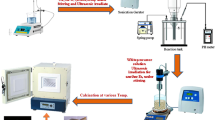Ceramic based on calcium phosphates is obtained from powders synthesized from water solutions of calcium nitrate, ammonium hydrophosphate, and ammonium pyrophosphate as well as from a mixed-anionic solution containing simultaneously ammonium pyro- and orthophosphate in the molar ratio (NH4)2HPO4/(NH4)4P2O7 = 1. The ceramic obtained contains biocompatible bioresorbable phases and can be used to make implants used in regenerative methods for the treatment of bone tissue defects. This represents the first time synthesis from mixed-anionic solutions is used to obtain powders of calcium phosphates with significant quantities of each anion.










Similar content being viewed by others
References
T. V. Safronova and V. I. Putlyaev, “Medical inorganic materials science in Russia: calcium phosphate materials,” Nanosistemy: Fiz., Khim., Matematika, 4(1), 24 – 47 (2013).
P. G. Koutsoukos, “Current knowledge of calcium phosphate chemistry and in particular solid surface–water interface interactions,” in: Proc. of the 2nd Intern. Conf. on Phosphorus Recovery for Recycling from Sewage and Animal Wastes, Institute of Chemical Engineering and High Temperature Chemical Processes, Univ. of Patras (2000), pp. 12 – 14.
S. Rajendran, M. V. Swain, and H. J. Rossell, “Mechanical properties and microstructures of co-precipitation derived tetragonal Y2O3–ZrO2–Al2O3 composites,” J. Mater. Sci., 23(5), 1805 – 1812 (1988).
S. Kannan, A. F. Lemos, J. H. Rocha, and J. M. Ferreira, “Characterization and mechanical performance of the Mg-stabilized β-Ca3(PO4)2 prepared from Mg-substituted Ca-deficient apatite,” J. Am. Ceram. Soc., 89(9), 2757 – 2761 (2006).
S. D. Miao, W. J. Weng, K. Cheng, et al., “A low temperature co-precipitation preparation of nano-sized zinc containing β-tricalcium phosphate powders,” Key Eng. Mater., 309, 565 – 568 (2006).
T. V. Safronova, V. I. Putlyaev, A. V. Kuznetsov, et al., “Properties of calcium phosphate powder synthesized from calcium acetate and sodium hydrophosphate,” Steklo Keram., No. 4, 30 – 34 (2011); T. V. Safronova, V. I. Putlyaev, A. V. Kuznetsov, et al., “Properties of calcium phosphate powder synthesized from calcium acetate and sodium hydrophosphate,” Glass Ceram., 68(3 – 4), 131 – 135 (2011) .
I. R. Gibson, S. M. Best, and W. Bonfield, “Chemical characterization of silicon-substituted hydroxyapatite,” J. Biomed. Mater. Res., 44(4), 422 – 428 (1999).
A. M. Pietak, J.W. Reid, M. J. Stott, and M. Sayer, “Silicon substitution in the calcium phosphate bioceramics,” Biomaterials, 28(28), 4023 – 4032 (2007).
I. R. Gibson andW. Bonfield, “Preparation and characterization of magnesium_carbonate co-substituted hydroxyapatites,” J. Mater. Sci.: Mater. in Medicine, 13(7), 685 – 693 (2002).
E. D. Eanes, “Thermochemical studies on amorphous calcium phosphate,” Calcified Tissue Res., 5(1), 133 – 145 (1970).
T. V. Safronova, V. I. Putlayev, K. A. Bessonov, V. K. Ivanov, “Ceramics based on calcium pyrophosphate nanopowders,” Proc. Appli. Ceram., 7(1), 9 – 14 (2013).
T. V. Safronova, V. I. Putlyaev, G. K. Kazakova, and S. A. Korneichuk, “Biphase CaO–P2O5 ceramic based on powder synthesized from calcium acetate and ammonium hydrophosphate,” Steklo Keram., No. 2, 34 – 41 (2013); T. V. Safronova, V. I. Putlyaev, G. K. Kazakova, and S. A. Korneichuk, “Biphase CaO–P2O5 ceramic based on powder synthesized from calcium acetate and ammonium hydrophosphate,” Glass Ceram., 70(1 – 2), 65 – 70 (2013).
T. V. Safronova, A. V. Kuznetsov, S. A. Korneychuk, et al., “Calcium phosphate powders synthesized from solutions with [Ca2 +]/[PO 3 −4 ] = 1 for bioresorbable ceramics,” Cent. Eur. J. Chem., 7(2), 184 – 191 (2009).
T. V. Safronova, V. I. Putlyaev,M. A. Shekhirev, and A. V. Kuznetsov, “Composite ceramic containing a bioresorbable phase,” Steklo Keram., No. 3, 31 – 35 (2007); T. V. Safronova, V. I. Putlyaev, M. A. Shekhirev, and A. V. Kuznetsov, “Composite ceramic containing a bioresorbable phase,” Glass Ceram., 4(3 – 4), 102 – 106 (2007).
T. V. Safronova, V. I. Putlyaev, S. A. Kurbatova, et al., “Synthesis and properties of amorphous calcium pyrophosphate powder, synthesized using ion exchange, for obtaining bioceramics,” Neorg. Mater., 51(11), 1269 – 1276 (2015).
Author information
Authors and Affiliations
Corresponding author
Additional information
Translated from Steklo i Keramika, No. 1, pp. 27 – 34, January, 2016.
Rights and permissions
About this article
Cite this article
Safronova, T.V., Knot’ko, A.V., Shatalova, T.B. et al. Calcium Phosphate Ceramic Based on Powder Synthesized From a Mixed-Anionic Solution. Glass Ceram 73, 25–31 (2016). https://doi.org/10.1007/s10717-016-9819-6
Published:
Issue Date:
DOI: https://doi.org/10.1007/s10717-016-9819-6




